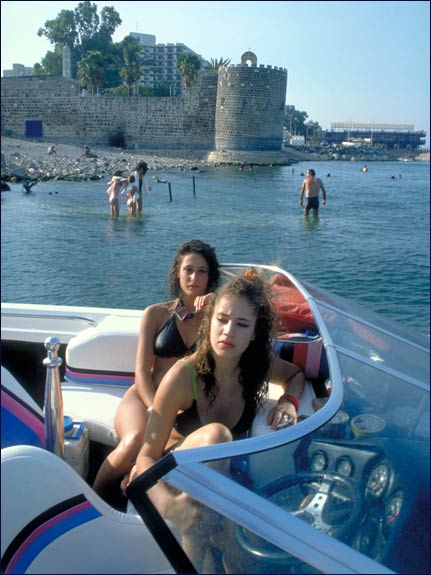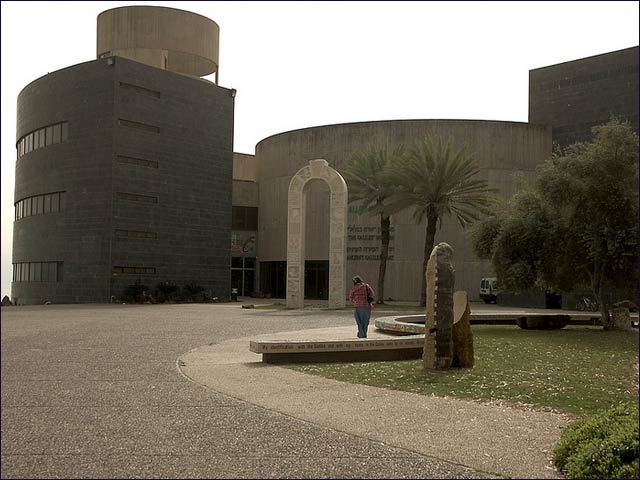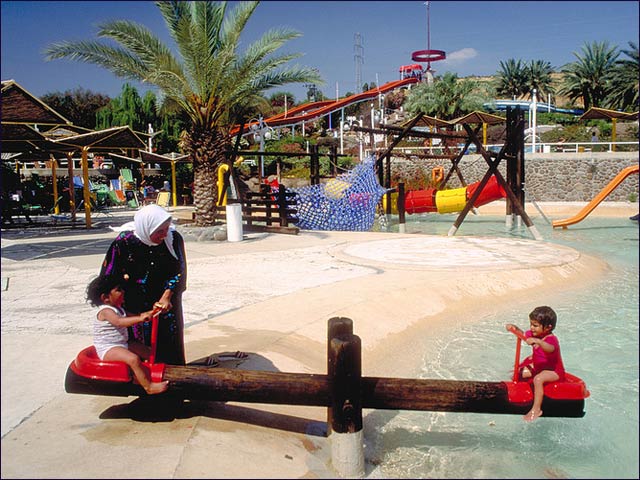By Avigayil Kadesh
You probably know it best as the Sea of Galilee, but Israel’s largest freshwater reservoir is actually a lake -- the only natural freshwater lake in the country and the lowest freshwater lake in the world.
Known as Lake Kinneret in Israel, this focal point of the Galilee is surrounded by beaches and a huge assortment of historic, natural, archeological, recreational and religious sites for visitors of all ages and interests.
The Kinneret, which receives most of its water from the northern Jordan River, naturally offers lots of boat rides and water sports. You can rent a canoe at places like Rob Roy’s Canoes near Kibbutz Kinneret, or book a cruise at the Yigal Alon Harbor in Tiberias, one of the lake’s most prominent and ancient shore cities.

Boating on the Kinneret
Photo courtesy of Israel Tourism MinistryThe lake area has been inhabited since the Stone Age, and many fisherman have long thrived in the shore areas. The Kinneret Sailing Company offers a one-hour expedition where guests watch a net-fishing crew at work and learn about fishing in the Sea of Galilee today. Up to seven people can book a hands-on, four-hour “Fisherman for a day” cruise. Both trips depart from the harbor at Kibbutz Ein Gev every Friday.
Home of the kibbutz
Speaking of the kibbutz, the communal movement had its start on the southern shores of the Kinneret. The very first cooperative farming village, Degania Aleph (A), was founded here by Romanian immigrants in 1909. Degania Bet (B) followed in 1920. Today at “Aleph” you can still see its first building, a small history museum and a stained glass gallery.
Degania Aleph’s Gordon House, founded in 1935, is one of the first nature museums of its kind in Israel. The museum’s rich collection tells the story of settlement in the area through artifacts found from inhabitants dating back to prehistoric times until the beginning of Zionism. It has a diverse taxidermy collection, films about the local nature and settlement of the area and an archeological display. And there are personal items and letters from A.D. Gordon, a pioneer hero of the "Second Aliyah,” the second wave of immigration from Russia between 1904 and 1914.
For a more modern treat, sign up for a three-hour workshop at Galita Chocolate Farm, a chocolate factory and retail outlet housed in a former old cowshed at Kibbutz Degania Bet. Proprietress Galit Alpert also runs a coffee bar selling homemade ice cream.
A Kibbutz Experience train tour takes visitors through Kibbutz Ein Gev, which offers lakeside guesthouses on the eastern shore of the Kinneret. The 30-minute guided tour leaves at 12:30 and 2:30 on Sundays through Fridays and every hour from noon till dusk on Saturdays and holidays. You’ll hear how the kibbutz, founded in 1937 by a group including Teddy Kollek, future mayor of Jerusalem, weathered attacks from Syria until the Six-Day War.
At Ein Gev’s harbor-side woodworking shop, Saba Yosi's Workshop, kids and their parents may build (or buy) wooden toys from kits and climb the pirate ship designed and built by Saba (Grandpa) Yosi. And there’s also the House of Anchors museum, opened in 1995 with a unique collection of ancient fishing-related artifacts found around the lake area, relating the story of fishermen in the Sea of Galilee in the last 3,000 years.
If you happen to visit during Passover, you can catch the annual Ein Gev Festival, the first music festival to be held in the state of Israel.
Animal lovers may enjoy Jungle Fun at Kibbutz Beit Zera, a petting zoo housing songbirds, toucans, rare mammals and a group of squirrel monkeys living in a tropical garden. Just northwest of the kibbutz is Tel Ubeidiya, a major archeological site discovered in 1959 that has yielded prehistoric remains starting from about 1.5 million years ago -- the oldest remains found outside Africa -- and more than 10,000 ancient stone tools.

Swimmers at Kinneret beach
Photo courtesy of Israel Tourism MinistryKibbutz Kinneret, where the beloved Israeli folksinger Naomi Shemer was raised (you can visit the Naomi Shemer House) also offers a pastoral Jordan Nature Reserve dotted with pools and inhabited by many bird species. An ancient channel of the Jordan River once flowed here, but what you see today is the result of a 1980s human effort. In this reserve you’ll find the "Buba tomb,” a monument dedicated to the legendary mule from the time of the early Zionist settlement in the area.
Kibbutz Ginosar’s Yigal Alon Center is where you can see the so-called “Jesus boat” – a 2,000-year-old craft lifted from the bottom of the Sea of Galilee in 1986. The center’s galleries trace the history of civilization and nature in the area. Alon was a founding member of the kibbutz, an active participant in the pre-state settlement movement, an officer in the Palmach and a government minister.

Yigal Alon Center
Photo courtesy of Israel Tourism MinistryKibbutz Gesher owns and manages Naharayim (“Two rivers”), an area straddling the Jordan and Yarmuk rivers near the Kinneret. Its original claim to fame was as the site of the first hydroelectric power plant in pre-state Israel, which no longer functions but is open for tours. Later, it was the setting for the signing of the 1994 peace treaty between Israel and Jordan. At that time, it was renamed the Island of Peace.
Explore the Island of Peace via a walking path by the dams and along the Yarmuk waterfalls. A guided tour will take you to Michal's Lookout and the Hill of Plucked Flowers, a garden memorializing seven Israeli schoolgirls murdered by a Jordanian soldier here in 1997. At the kibbutz, you can watch a sound-and-light show and visit an underground military history museum.
National parks, water parks
In addition to the Kinneret’s family-friendly beaches, there are three water parks on its shores: Luna Gal, Zemach Beach and Gai Beach.

A water park near the Kinneret
Photo courtesy of Israel Tourism MinistryThe area also boasts several sites managed by the Israel Nature and Parks Authority.
Part of this reserve is the natural wetlands of Bethsaida Valley, northeast of the Sea of Galilee and encompassing streams, pools, springs and fishing lagoons. The valley is connected with the ancient city of Bethsaida, where archeologists are excavating Bronze Age and Iron Age remains as well as remnants of the Roman period at the beginning of the last millennium.
The Majrassa area really lets you get your feet wet, beginning with a paved trail leading to the banks of the Daliyot Stream. You can get into the water and wade downstream, where you may choose to leave via a staircase at the eucalyptus grove, or continue to the end of the marked trail. A dry route takes hikers along the southern bank, leading to a picnic area in the eucalyptus grove.
Kokhav HaYarden, or Star of the Jordan (Belvoir) National Park is at the edge of a steep slope above the Jordan Valley. Its main highlight is a reconstructed Crusader fortress built around 1140. It’s the most complete Crusader fortress in Israel and the only one that has been fully excavated. The fortress is surrounded by a wide, deep moat, and sculptures by the Israeli artist Yigael Tumarkin are on display south of the fortress. On the north side is a Griffon vulture feeding station.

A view across the Kinneret to the Golan Heights
Photo courtesy of Israel Tourism Ministry Hot springs
One of the biggest draws in the Kinneret area is the natural hot springs.
Tiberias Hot Springs consists of ancient pools fed by 17 natural springs, where you can get massages, mud treatments and Turkish baths. The site has indoor and outdoor thermo-mineral pools, a hot tub, heated swimming pool, private beach (with separate areas for religiously observant men and women bathers), saunas and gym.
About five miles southeast of the Kinneret is Hamat Gader Hot Springs, one of Israel’s most popular attractions. The thermo-mineral springs have a steady temperature of 42 degrees Celsius (107 Fahrenheit), which is why the ancient Romans built their second-largest bath complex (Israel’s largest) here 2,000 years ago. It was popular with Jews as well, as evidenced by an ancient synagogue with a beautiful mosaic floor. Today you can get a full range of pampering and therapeutic treatments here.
Hamat Gader Park also has 40 acres of tropical parkland with covered outdoor settings, restaurants, and one of the largest crocodile farms in the Middle East, housing about 200 of the reptiles.
Cool ways to get around
Cruise the lake in a floating restaurant, fishing boat, kayak or canoe. For the more sports-minded, there are opportunities for kite surfing and windsurfing. In fact, kite surfer Sammy Ben Ami calls the Kinneret “the best kite surfing beach in Israel” during a season that generally lasts from late May through August.
Out of the lake, you can explore the environs of the Kinneret in several fun ways.
Shvil Sovev Kinneret (trail encircling the Sea of Galilee) is the newest route to walk or bike around the lake. This ambitious project comprises more than 60 kilometers. Bike-riders (you can rent one if you don’t have yours along) usually begin at Kibbutz HaOn and continue past the Degania Dam to Kibbutz Kinneret.

A view of the Tiberias harbor at night
Photo courtesy of Israel Tourism MinistryJordan Carriages will put you into a horse-drawn carriage in the southern Jordan River area, where you’ll hear local stories, sing the songs of the famed Israeli poetess Rachel and folksinger Naomi Shemer and stop to bake pita bread on a taboun stove to top with labaneh (strained yogurt cheese), olive oil and za’atar (Middle East herb mix).
Several companies are in the business of jeep treks or ATV adventures through the Galilee, including Lake Kinneret on the itinerary.
The “Sovev Kinneret - Around the Sea of Galilee” bus line, introduced in 2010, takes passengers from Tiberias to all of the Kinneret beaches for free. During the summer months, buses leave every two hours between 8 am and 10 pm from the Galil Center, circling the lake once from the north and once from the south.